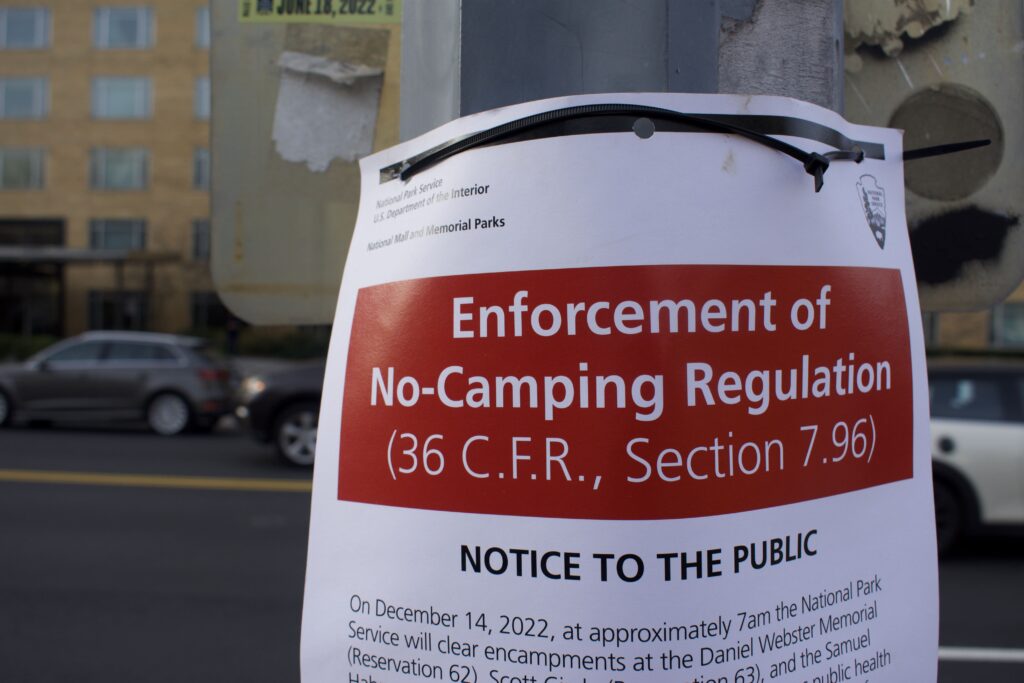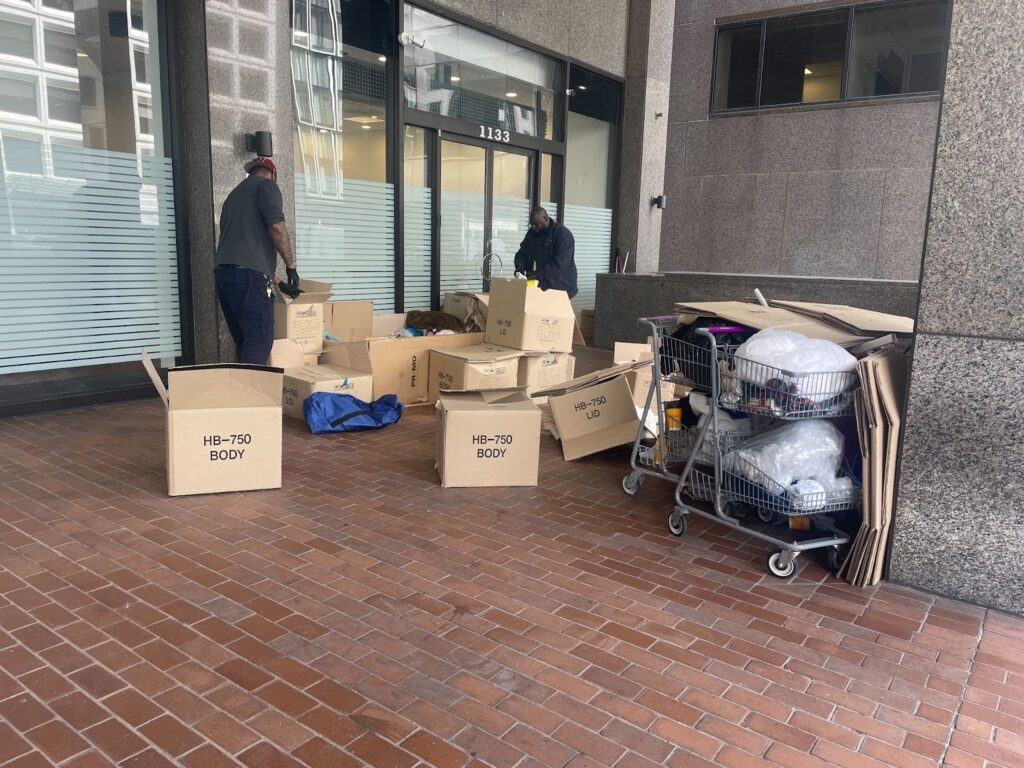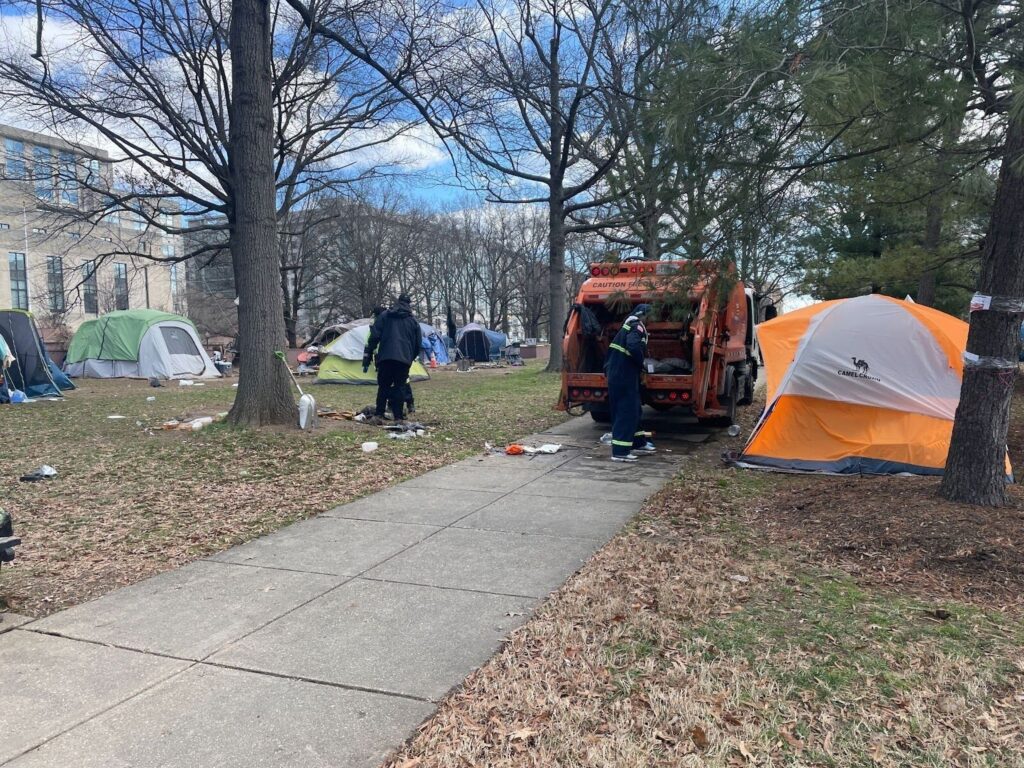It was just 30 degrees outside when Jamaar Andre Taylor unzipped the outer flap of his tent to find a dozen people telling him he had to leave.
On the morning of Dec. 14, the National Park Service (NPS) closed the Scott Circle encampment where Taylor lived. NPS, which controls the traffic circle’s green spaces, allowed people to set up tents there during the early years of the pandemic. But the federal agency plans to clear all encampments on federal land in D.C. by the end of 2023.
In its most recent action, NPS cleared Scott Circle during a hypothermia alert issued by the D.C. government, meaning the dozen displaced residents, including Taylor, packed and searched for a new place to sleep in below-freezing temperatures.
While NPS generally avoids clearing encampments during extreme weather, the agency went ahead with this scheduled closure because it felt the site posed an “imminent health and safety concern,” according to NPS spokesperson Mike Litterst. He pointed to past criminal activity as a justification for closing the park. Since September, the U.S. Park Police has made 12 arrests and found nine weapons at the park. One encampment resident was shot on Sept. 30, and another died of an overdose in November.

When NPS arrived at Scott Circle at 8 a.m. it was 29 degrees outside, and felt even colder with the wind chill. Residents could see their breath as they moved their belongings onto the sidewalk or loaded them onto bikes and shopping carts.
“There should be laws against this,” Taylor said. “It’s too cold.”
“We in hypothermia season,” shouted Donetta, who was wearing a faux mink coat. She, like most of the residents, didn’t have anyone to help her move. She grabbed a shopping cart from a nearby store, and spent hours pushing it between Scott Circle and her new location.
D.C. activates hypothermia alerts when the temperature falls below 32 degrees. On the day of the clearing, the alert was in effect until 11 a.m., when NPS left.
Both NPS and D.C. follow protocols that prohibit closing encampments in extreme weather unless there is an immediate need, with some exceptions. But the city’s policy isn’t clear on what constitutes an exception, listing only the criteria of “an emergency, security risk, health risk or safety risk.” NPS uses similar parameters, allowing closures during hypothermia season only in the case of “imminent health and safety risks,” Litterst said.
This summer, the city closed one encampment during a heat emergency, saying it was on private property that was about to be landscaped. In the case of Scott Circle, NPS went ahead despite the cold weather because of concerns about further criminal activity, Litterst said.
None of the half-dozen encampment residents Street Sense Media spoke to had an indoor place to stay after the closure. Several residents couldn’t carry their tents with them because they were too heavy or bulky. Others worried they wouldn’t have enough time to find a new place to sleep before the predicted freezing rain began that night. D.C.’s low-barrier shelters have been nearly full since September, though some overflow shelters have vacancies, according to The Community Partnership’s nightly census.

The Scott Circle encampment was one of dozens on federal land in the District. The Park Service has already removed encampments at Union Station; Mount Vernon Square; and the adjoining Burke and Gompers parks, which straddle 11th Street along Massachusetts Avenue NW. Litterst estimates about 25 encampments remain, including one at McPherson Square that NPS plans to close in April. In explaining the rationale for clearing the parks, NPS cited a need to renovate them to open the spaces to the public. Burke and Gompers, the only site to reopen thus far as public parkland, did so one day after NPS cleared Scott Circle and over a year after NPS initially closed the encampment.
Critics of encampment clearings argue closures displace people who live outside, without necessarily connecting anyone to housing. “Where are we supposed to go?” more than one resident asked during the Dec. 14 clearing.
NPS says that’s a question for the city to answer. When NPS clears an encampment, it asks the District to work with residents to find housing. According to the signs posted at Scott Circle, service providers contracted by the city offered residents “intensive case management.” But according to service provider Miriam’s Kitchen, only three residents were matched to a housing resource. And just being matched doesn’t guarantee a place to sleep.
Taylor has been matched to a voucher, so he qualifies for bridge housing or PEP-V. Someone was supposed to take him to the program’s hotel the day before the clearing. But he took medicine to help him get through the cold night and slept through his pickup time. Then, passersby harassed him. He said people often throw trash at him, making it look like he can’t keep the area clean when it accumulates around his tent.
“It’s an overwhelming situation,” he said. “I’m scared because you get taken the wrong way out here.”
When NPS officers arrived at Taylor’s tent, he told them to take everything but a gold bike and one bag. He left the circle before NPS threw his tent away. An hour later, Taylor hadn’t yet come back for his belongings.

A slightly different version of this article appeared online.
This article was co-published with The DC Line.
Annemarie Cuccia covers D.C. government and public affairs through a partnership between Street Sense Media and The DC Line. This joint position was made possible by The Nash Foundation and individual contributors.








